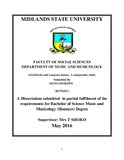Please use this identifier to cite or link to this item:
https://cris.library.msu.ac.zw//handle/11408/2357Full metadata record
| DC Field | Value | Language |
|---|---|---|
| dc.contributor.author | Moyo, Sinikiwe | - |
| dc.date.accessioned | 2017-06-30T07:17:11Z | - |
| dc.date.available | 2017-06-30T07:17:11Z | - |
| dc.date.issued | 2016-05 | - |
| dc.identifier.uri | http://hdl.handle.net/11408/2357 | - |
| dc.description.abstract | The study compared izangoma and isitshikitsha dances performed at Dinyane village in Tsholotsho. There is very limited literature on the performance of these dances. Comparing and documenting these two dances among others will bring an understanding of their differences in the coming generations. In this study the researcher made use of a qualitative research design in form of ethnography. Data was collected from the villagers. The researcher chose knowledgeable people like the traditional healers who are also dancers and some elderly people in the village. Purposive and snowball sampling technics were used in identifying suitable informants with the required knowledge. Participant observation and interviews were used to collect data. Research findings showed how different isitshikitsha is to izangoma. It also revealed the similarities between the two and the reasons why people confuse them. Many people perform izangoma thinking that they are performing izangoma because the dances are no longer performed in their original contexts. The research creates knowledge on the two dances. Izangoma is a dance performed for the appeasement the ancestral spirits while isitshikitsha is performed for entertainment. The themes of the songs are different and so is the attire. Isitshikitsha is performed by ladies only while izangoma is performed by both males and females who have izangoma sprits. The clapping and the dance rhythms are the same. Researchers are recommended to document the dances and transcribe the songs for preservation. The education sector can also be used as a preservation measure if the traditional dances become one of the compulsory extracurricular activities. Those willing to engage in a similar study should consider looking at the reasons why several spirits possess one person. | en_US |
| dc.language.iso | en | en_US |
| dc.publisher | Midlands State University | en_US |
| dc.subject | Isitshikitsha dance. | en_US |
| dc.subject | Izangoma dance. | en_US |
| dc.title | Isitshikitsha and izangoma dances. A comparative study. | en_US |
| item.fulltext | With Fulltext | - |
| item.grantfulltext | open | - |
| item.languageiso639-1 | en | - |
| Appears in Collections: | Bsc Music And Musicology Honours Degree | |
Files in This Item:
| File | Description | Size | Format | |
|---|---|---|---|---|
| Moyo Sinikiwe.pdf | Full text | 3.23 MB | Adobe PDF |  View/Open |
Page view(s)
652
checked on Nov 23, 2025
Download(s)
966
checked on Nov 23, 2025
Google ScholarTM
Check
Items in MSUIR are protected by copyright, with all rights reserved, unless otherwise indicated.



